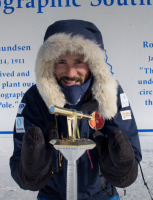Climate Change
Ice-sheet Melting
Sea-level Rise & Erosion
Post-Doctoral Fellowships
United Kingdom
2016.12.31
Investigating the stability of ice shelves to assess Antarctica's future Sea Level Rise contribution
Evaluating the stabilising role of suture zones on Antarctic ice shelves
Indeed, to evaluate the probability of the collapse of Antarctica's ice shelves, Dr. Sarah Thompson will not only study the destructive forces in play, but also the constructive ones. In particular, her study will examine the properties, geometry and spatial distribution of suture zones – narrow interstitial sections of ice shelves composed mainly of marine ice. Using satellite images, Dr. Sarah Thompson and her team will also map other structural features affecting ice-shelf stability, such as rifts and basal crevasses. The researchers will also map the spatial distribution and frequency of surface melt ponds. In addition, they will also use existing data on ice volume and velocity of grounded glaciers to assess the magnitude of the impact of the collapse of different ice shelves. Finally, the study will identify, where possible, climatically vulnerable ice shelves depending on their geographical position using current models of atmospheric and ocean warming.
"By improving our understanding of the factors contributing to ice shelf stability, we can improve our predictions of future sea level rise", explains Dr. Sarah Thompson. "By investigating the stability of Antarctic ice shelves, I aim to contribute to more accurate models, and therefore to a better response". Building on a study conducted on one particular ice shelf called Larson C, Dr. Sarah Thompson's study aims to investigate the extent to which the processes and features contributing to ice shelf stability on Larson Care controlling other ice shelves. By helping to improve predictions of the timing and magnitude of future sea level rise, her findings will contribute to better mitigation and adaptation to the changes ahead.

Sarah
THOMPSON
Institution
Geography College of Science Swansea University
Country
United Kingdom
Nationality
British
Related articles
Climate Change
Finance, Investment & Risk Management
Societal Challenges
Climate Adaptation & Resilience
Insurance & Risk Management
Environmental Justice
Civil Society & Governance
AXA Project
Italy
AXA Research Lab on Climate Change, Risk and Justice
In response to three research questions: How can the private and financial sectors contribute to a just transition to a... Read more

Gianfranco
PELLEGRINO


